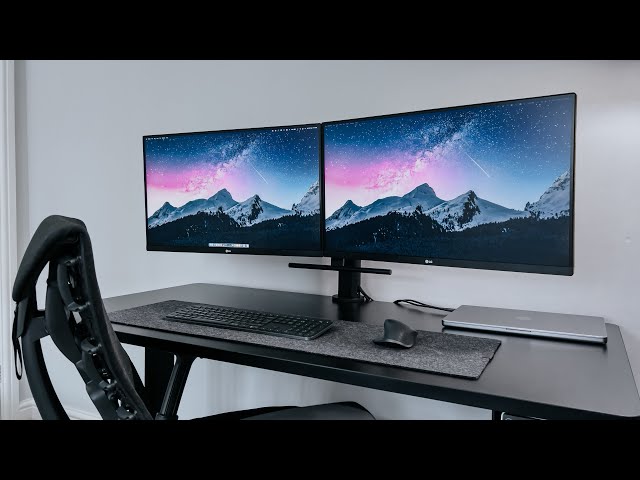

Dual monitors can turbocharge your workflow, but if they are not ergonomically positioned, they’ll wreak havoc on your neck.
Whether you are editing spreadsheets, gaming, or designing the next big thing, poor screen setup leads to chronic neck strain, upper back stiffness, shoulder pain, and a slow descent into tech-induced posture misery.
As per bestforwardheadposturefix.com, “But do not ditch the second screen just yet—this guide is packed with practical, research-based advice on how to arrange dual monitors to prevent neck strain”.
Apart from revealing how to fix nerd neck naturally, you also learn how to get your neck upright in order to get your productivity flowing.
Why Dual Monitors Can Strain Your Neck?
Using two monitors often forces users into unnatural head positions.
When you constantly swivel between screens—especially when they are unevenly placed—you create repetitive strain on the neck and upper back muscles.
This asymmetry increases tension in the sternocleidomastoid and upper trapezius, leading to discomfort or long-term posture damage. The risk multiplies when you favor one screen over the other or use monitors of different sizes.
Understanding why this happens is the first step toward building the best dual monitor setup for neck posture and long-term spinal health.
Ideal Placement for Primary and Secondary Monitors
If you rely more heavily on one monitor, make that screen your focal point by placing it directly in front of you.
The second monitor should be angled slightly inward, typically at a 20-degree angle, so you can glance at it with minimal head movement.
This configuration supports a more natural posture and helps you avoid over-rotation of the cervical spine.
This kind of thoughtful dual monitor placement for neck health helps reduce repetitive motion injuries while allowing you to multitask without compromising comfort.
What to Do If You Use Both Screens Equally?
When your workflow requires using both monitors equally—say, editing on one and referencing data on the other—a balanced, centered setup is essential.
Sit directly between the two screens so that your nose aligns with the gap or slight overlap between them.
Then, angle each monitor inward slightly, like the open covers of a book. This setup creates a smooth, symmetrical viewing arc, allowing your eyes to glide effortlessly between displays without turning your head.
For example, a graphic designer editing visuals on one screen while using the second for client feedback should avoid constantly leaning to one side.
Similarly, a financial analyst comparing charts side-by-side benefits from equal screen access without straining the neck. This arrangement reduces muscle imbalance, prevents unilateral tension buildup, and minimizes spinal twisting.
If you’re serious about dual monitor positioning to reduce neck fatigue, maintain posture symmetry, and stay comfortable during long hours, this setup should be your default.
Aligning Screen Height and Tilt
Misaligned monitor heights can cause neck tilt, which might seem harmless at first but accumulates strain over time.
Both monitors should be adjusted so that their top edges are at or just below your eye level, with a slight upward tilt of about 10 to 20 degrees.
This helps keep your chin level and your neck in a neutral position. Adjusting dual monitor height for neck posture is especially important for professionals who spend eight or more hours at a desk.
You would immediately feel the difference in reduced tension and visual comfort.
Proper Monitor Distance
The ideal distance for any monitor—especially in a dual setup—is between 20 and 30 inches from your eyes.
That is about an arm’s length. Placing monitors too close forces your eyes and head to shift constantly, while placing them too far encourages forward head posture.
Finding the sweet spot helps maintain visual focus without pulling your head out of alignment. Maintaining appropriate distance is a subtle but crucial part of optimizing dual screens for ergonomic neck pain tips that really work in daily life, whether you are working, gaming, or studying.
Choosing Screen Size and Monitor Type
While ultra-wide and oversized monitors are popular, they can be risky for your posture. Large monitors placed side-by-side may force excessive horizontal neck movement if not angled correctly.
Curved monitors can help reduce this range of motion, but only if set up properly. Keep individual screen sizes in the 22–30 inch range and use monitors with slim bezels to reduce the visual and physical gap between them.
Avoiding neck pain with dual displays is not about having the biggest screens—it is about having the most appropriately positioned ones.
The Case for Dynamic Monitor Setups
Static postures, even if technically “correct,” can still cause pain when maintained too long. A dynamic setup—using adjustable monitor arms or stands—lets you shift monitor height and angle as your body moves throughout the day.
One ergonomic study showed that people who adjusted their screen position regularly had significantly less neck stiffness than those with fixed screens.
By enabling micro-adjustments, dynamic setups allow for natural movement and adaptation, making them ideal for anyone serious about implementing a dual monitor setup for neck posture that evolves with their workflow.
>>> Want to Learn How I “Fixed My Text Neck” at Home??? Click Here to Find Out! <<<
Helpful Ergonomic Tools
The right tools are not just accessories—they are your neck’s best friends in the digital age.
Monitor arms are like yoga instructors for your screens: they twist, tilt, stretch, and adjust until everything aligns just right. With a couple of easy tweaks, you can kiss those awkward neck angles goodbye.
Got mismatched monitors?
No problem.
A good dual monitor stand keeps both screens standing tall and united like twin soldiers in perfect formation.
And if you are working with flat-panel monitors with ultra-thin bezels, you would barely notice the divide—no more dramatic head-turns just to read a line of text.
Still stuck with inflexible gear?
That is where VESA mounts and trusty desk risers come to the rescue, lifting your screens—and your posture—to new heights. It is all part of smart dual monitor positioning to reduce neck fatigue without breaking the bank or your cervical spine.
Let’s be real: aesthetic setups are great, but what you really want is to avoid ending each day feeling like your neck’s been in a headlock.
These tools are part of the holy grail of dual screens ergonomic neck pain tips—turning a pain in the neck into a thing of the past.
Posture, Chair, and Desk Alignment
Even the best monitor setup would not save you if the rest of your workstation is working against you.
Start by aligning your body: your feet should be flat on the floor, knees slightly below hip level, and shoulders relaxed.
Your ears should sit directly above your shoulders—not forward like a turtle.
Use a chair with lumbar support and a height that keeps your forearms parallel to the floor.
These foundational adjustments complement your dual monitor placement for neck health, creating a full-body approach to ergonomic integrity.
Breaks, Stretches, and Movement Routines
No amount of perfect monitor placement can replace the need to move.
Follow the 20-20-20 rule: every 20 minutes, take a 20-second break and look at something 20 feet away.
Add light neck stretches, chin tucks, and rows to your hourly routine. These small interventions release built-up tension and improve blood flow.
A study on desk workers found that hourly movement breaks decreased reported neck pain by nearly 40%.
Pairing proper monitor positioning with movement routines makes for a highly effective approach to reducing neck strain with dual displays.
FAQs on Dual Monitors for Neck Posture Correction
Q-1: How do I position two monitors so my neck isn’t constantly twisted?
A-1: Make one primary screen directly in front of you (center of torso to the screen’s midpoint).
Put the secondary screen at a slight arc to one side so your head turns ≤15° for most glances. Top edges level, with the screen center about eye height (or the top bezel 2–3 cm below eye level). Sit 50–70 cm away so you scan with your eyes, not your neck.
If you truly use both equally, angle them inward like an open book and center the bezel gap on your nose.
Q-2: What’s the best layout if I write on one screen and read/reference on the other all day?
A-2: Put the editing/creation app on the centered primary monitor. Keep reference material on the side screen but narrow its width so the text column matches your natural eye sweep (45–65 characters per line).
Park high-change items (chat, timelines) nearest the inner edge to minimize head rotation, and pin low-change items (PDF, spec) farther out.
Use window-snapping shortcuts so you can reshuffle layouts without leaning.
Q-3: My neck still aches—what micro-habits lower strain without killing productivity?
A-3:
20–20–20 vision rule: every 20 minutes, look 20 feet away for 20 seconds.
Chair—not neck—turns: swivel your whole torso when reading long passages on the side screen.
Hotkeys > head turns: learn OS shortcuts (Alt+Tab, Win+Arrow, Mission Control) to move content to the primary screen instead of staring sideways.
Micro-mobility: once per hour, do 3 chin nods, 3 shoulder rolls, and a 30-second chest stretch.
Q-4: How should I adjust for glasses, laptop docking, or a sit-stand desk?
A-4:
Progressive/bifocal lenses: drop monitors 2–4 cm lower than usual to avoid neck extension; tilt screens back 10–20° so you look through the lower lens without craning.
Laptop + monitor: raise the laptop on a stand to match the external monitor’s top line and use an external keyboard/mouse so your shoulders stay square.
Sit-stand: save two presets—one seated, one standing—so monitor height and eye line stay consistent when you switch.
Q-5: What hardware/software tweaks make the biggest difference with dual displays?
A-5:
VESA arms to fine-tune height, depth, and angle; keep a 1–2 cm bezel gap if the pair is symmetrical.
Pointer settings: increase pointer speed slightly and enable “switch primary monitor” hotkey so the active window follows you (many display utilities offer this).
Curved or matched-size panels: reduces outer-edge distortion and head travel.
Document holder between screens for heavy transcription work.
Taskbar/dock on the primary only, so quick glances land straight ahead—not sideways.
Bottom line: Center your most-used work, keep head turns tiny and brief, move windows with shortcuts (not your neck), and let adjustable hardware do the fine work so your posture doesn’t have to.
Sample Setup Guide
Here is how to build a posture-friendly dual monitor workspace that keeps your neck in check and your productivity high:
- Place your primary screen directly in front of you, centered with your body, about an arm’s length away. This minimizes neck rotation and eye strain during extended use.
- If the second monitor is used less frequently, angle it inward by about 20 degrees so you can glance at it with minimal head movement.
- When using both monitors equally, position them side by side and angle them inward slightly, forming a shallow “V” shape. This allows smoother visual transitions without excessive neck turning.
- Ensure both monitors are the same height, with top edges aligned at or just below eye level to maintain a neutral neck position.
- Tilt each monitor upward slightly, between 10 and 20 degrees, to match the natural line of sight without tilting your head forward or down.
- Use monitor arms or risers to make fine-tuned height and distance adjustments based on your sitting posture.
- Maintain an upright seated posture with feet flat, spine neutral, shoulders relaxed, and your back fully supported.
- Take stretch breaks every hour, incorporating gentle neck movements and posture resets to reduce fatigue and muscle tension.
By following these steps, you are effectively addressing all the ergonomic concerns around dual monitor positioning to reduce neck fatigue and enhance long-term comfort.
Takeaway
Dual monitors can either be a gift to your productivity or a curse on your cervical spine. The difference lies entirely in how you set them up.
Thoughtful arrangements—like centering, height alignment, and proper angle—will do wonders for your posture.
But do not forget the importance of breaks, movement, and supportive furniture.
Your goal is not just to use two screens—it is to use them well.
A smart setup reduces fatigue, improves focus, and makes your day more comfortable. Whether you are working from home or in an office, keeping your neck healthy should always be a priority.
Now that you know how to arrange dual monitors to prevent neck strain, you have officially got no excuse for turtle neck posture.
Set it up right, sit tall, and let your neck thank you later.
References:

